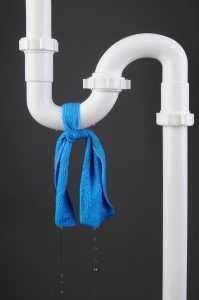Putting a Stop to Your Under-Sink Plumbing Leak

It probably goes without saying that plumbing leaks are one of the most frustrating and inconvenient home comfort issues to contend with, especially when it seems like something that should be an easy fix that you can just handle on your own. Leaks waste more water than you may realize, and cause pretty big messes. And they happen for any number of reasons.
With professional Sugarland, TX plumbing repair from our team, you’ll have professionals who are not only able to discover the precise location of the leak, but also determine the cause, and reduce the chance of it happening again. But doing so effectively depends on a few different factors.
Is It a Bathroom or Kitchen Sink That’s Leaking?
Before our team can help you determine possible causes—and solutions—for your under-sink plumbing mishap, we have to ask: is the leak coming from a bathroom sink, or a kitchen sink? There are some small differences in how each of these work, and therefore our answer in how to resolve it will differ.
For instance, your bathroom sink has a component called a “tail piece.” This is a straight pipe that extends from the bottom of the sink, and usually has a rod protruding on the back, which is connected to the faucet with another pipe. This grouping is known as the sink stopper assembly , and that tail piece also connects to an “S” shaped pipe called the P trap.
Leaks can occur from any number of these components in a bathroom sink, but it’s going to look a bit different in a kitchen sink. This is because your kitchen sink doesn’t include the sink stopper assembly. Though, it may have an attached hose above the dishwasher trap. You’ll likely also notice that a double kitchen sink is equipped with a pair of connect lines above the trap, that comes in from both sides.
Your Under-Sink Pipes
In many cases, leaks are located on a joint related to the waste water pipe. Your sinks’ drains are responsible for moving a lot of water on a daily basis, and this constant movement can cause a variety of changes that could lead to a leak.
The under-sink plumbing components in most of today’s homes include white or black plastic pipes, while in older homes they might be chrome. When it comes to locating the leak, the type of pipes aren’t necessarily important—but this is important when it’s time to repair the leak—the replacement parts must match the ones that are currently installed in order to avoid being stuck with the same problem.
Finding the Source of the Leak
Generally speaking, the source of an under-sink leak is going to be fairly easy to find, since there will likely be a pool of water under it. If you’re in doubt, though, turn the faucet on to see where the water is coming form. It’s most likely going to be leaking from a joint, rather than a section of pipe. It could even be as simple as a pipe that was jarred or bumped out of position, and most times with plastic fittings you can simply push the pipe back into position.
However, as easy as this fix sounds, it’s very rarely a permanent solution, which is why it’s important to call in a professional plumber. You might need to have a failed washer replaced, a joint sealed, or a piece of pipe replaced. If it is a misaligned pipe that’s causing your leak, however, the best thing you can do to avoid this problem in the future is to try not to hit or bump any piping when you put things like cleaning supplies and toiletries under your sinks.
For plumbing services you can depend on, contact Doug Turner Plumbing CO. today!
The post Putting a Stop to Your Under-Sink Plumbing Leak appeared first on Doug Turner Plumbing CO..
CONTACT INFORMATION
Physical: 9945 Mula Rd. Stafford, TX 77477
Mailing Address: PO Box 1177 Sugar Land, TX 77487
Phone: (281) 201-6065

